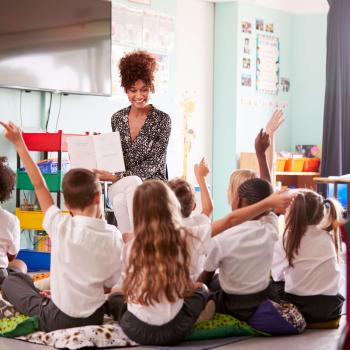Teacher Read-Aloud That Models Reading for Deep Understanding

About this Strategy Guide
Teacher read-alouds demonstrate the power of stories. By showing students the ways that involvement with text engages us, we give them energy for learning how reading works. By showing them how to search for meaning, we introduce strategies of understanding we can reinforce in shared, guided, and independent reading.
Research Basis
Marie Clay (1991) writes that when teachers read aloud to students “meanings can be negotiated in discussion before, during, and after the story reading” (p.171). Reading aloud to students should include think-aloud or interactive elements and focus intentionally on the meaning “within the text,” “about the text,” and “beyond the text” (Fountas & Pinnell, 2006, p.33). Read aloud, as part of the gradual release of responsibility, feeds naturally into shared, guided, and independent reading as teachers demonstrate for students the ways the reading process works (Burkins & Croft, 2010).
Among the many benefits of read aloud, Rog (2001) lists the following:
- building vocabulary
- developing understandings of story structures
- supporting developing connections between print elements
- encouraging high levels of understanding
- teaching the reading process in a meaningful context
- modeling fluency
- motivating students to read
Strategy in Practice
Part 1: Before Reading Aloud
- Consider the speaking vocabulary of the class. A read aloud text should engage students at the edge of their speaking vocabulary, usually a grade or two above their grade-level.
- Among text options, select based on relevant criteria below:
- Will students enjoy it?
- Is there a big idea or theme to explore?
- Are there opportunities for thinking deeply?
- Do students have necessary background knowledge?
- What are the vocabulary demands?
- Are the illustrations compelling?
- Do the story and the illustrations present cultural diversity?
- Consider the deep understandings you want to support students in reaching through discussion. What is a “big idea” you want students to explore?
- Working backward from your big idea, write open-ended questions on sticky notes or in the margins in the places you want students to discuss them. Develop questions that will support student discussion and depth of thought as they move in the direction of this big idea. This isn’t a search for “right answers,” nor does it eliminate the possibility of other ideas surfacing during discussion. This guiding idea is simply a plan for supporting thoughtful discussion.
- Examine the vocabulary in the text. Are there words that students must know in order to arrive at understandings around the “big idea”? Develop a plan for introducing words quickly before or during reading.
- Practice reading the text aloud.
Part 2: During & After Reading (four parts)
- Introduce preliminary vocabulary. Don’t spend too much time on this.
- Read the text aloud fluently, stopping to ask the questions you wrote during planning. Allow students to discuss them with partners and then share out with the group. Continue this process until you reach the end of the story.
- After reading, support deeper conversation in the direction of the big idea. Support students as they mine for connections and push for deep thought, particularly around the big idea.
- Make the text available for shared, guided, and independent reading opportunities. Locate related texts for sharing with students.
For further reading:
Anderson, N.P. (2007). What should I read aloud? A guide to 200 best-selling picture books. Newark, DE: International Reading Association.
Burkins, J.M., & Croft, M.M. (2010). Preventing misguided reading: New strategies for guided reading teachers. Newark, DE: International Reading Association.
Hickman, P., & Pollard-Durodola, S.D. (2009). Dynamic read-aloud strategies for English learners: Building language and literacy in the primary grades. Newark, DE: International Reading Association.